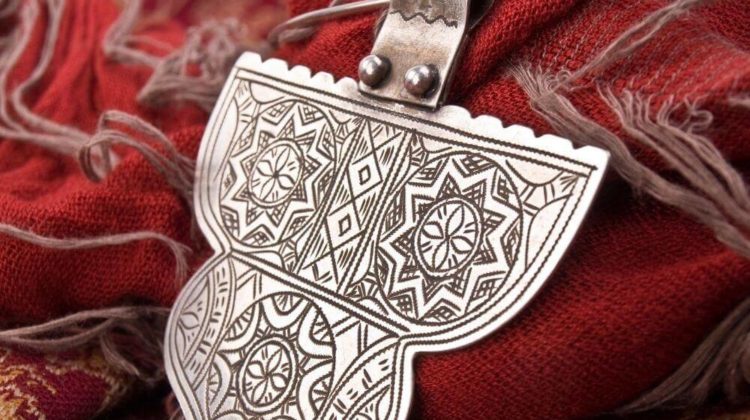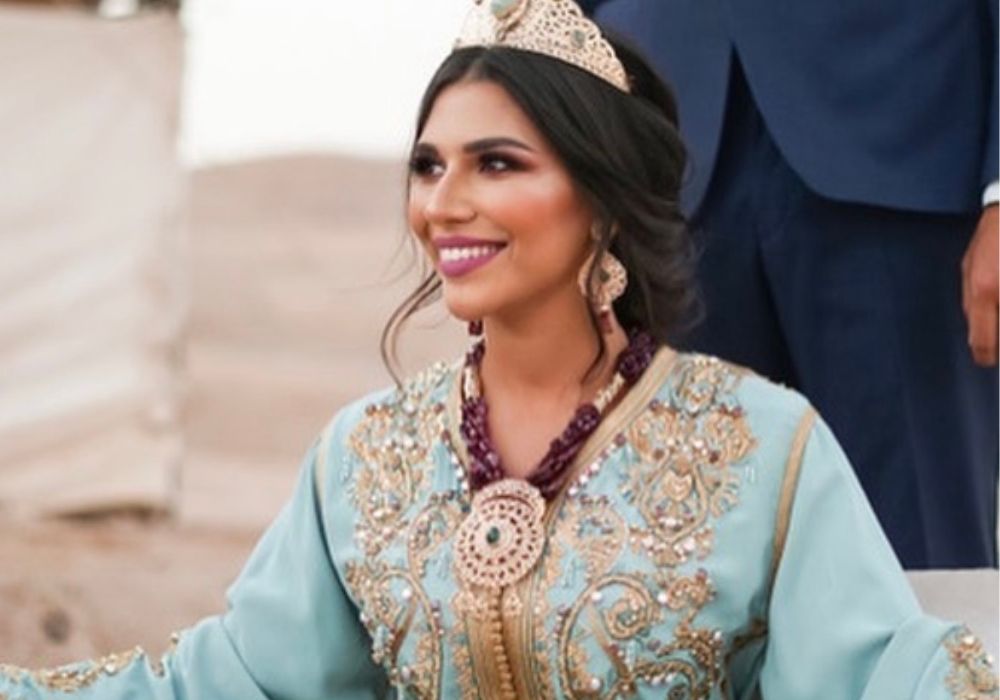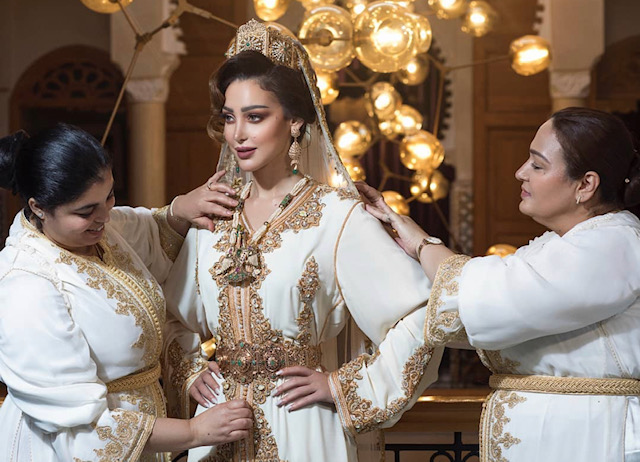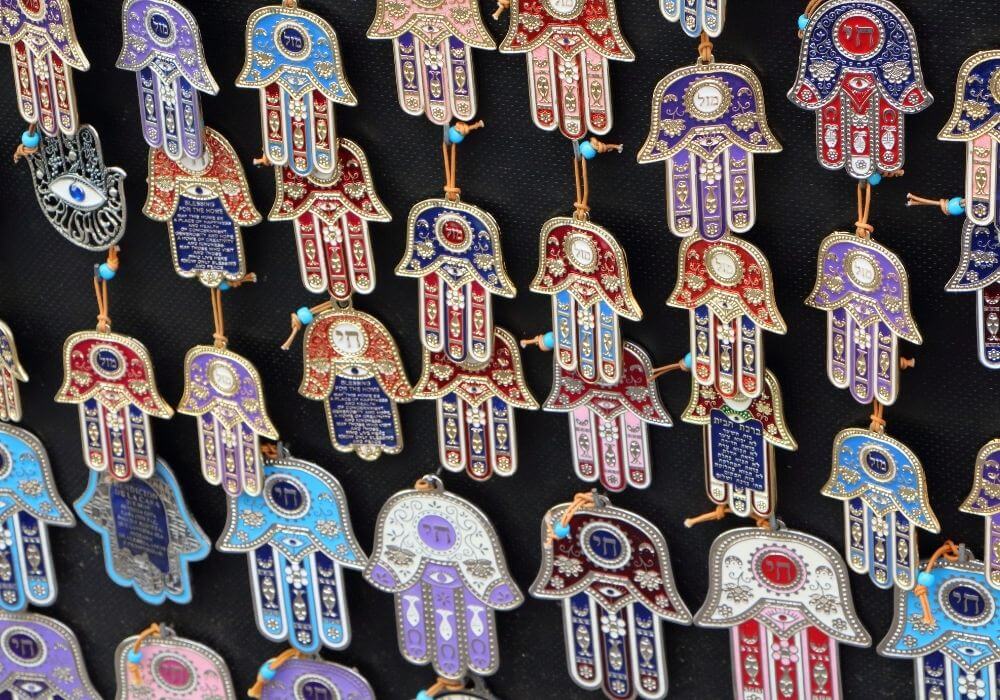
Morocco has an ancient tradition of artisanal jewelry and craftsmanship that extends into our modern era. Jewelry is one of the most prized possessions Moroccan women own.
The traditional art of making genuine Moroccan jewelry can be attributed, for the most part, to Morocco’s Jewish population, back in the day.
Jewish craftsmen and artisans were established as the best designers and creators of these pieces.
In this comprehensive guide to Moroccan jewelry, we delve deeper into the types of jewelry, their region of origin, the occasions they’re made for, as well as where one can acquire authentic pieces.
Some links below may be affiliate links. As an Amazon Associate I earn from qualifying purchases.
Table of Contents
Moroccan Jewelry by region
When speaking of Moroccan jewelry, your brain instantly conjures up images of those chunky and elaborate Berber necklaces or those intricate bridal accessories that drape the hair, arms, and neck.

Most notably, two particular traditions of jewelry craftsmanship come to mind: Berber and Tuareg. Berber jewelry illustrates tribal customs and traditions.
In this regard, it becomes an integral part of a woman’s dowry. Berber women are o
ften depicted in photographs wearing large amber necklaces, headbands embellished with layers of silver coins, and hinged metal bracelets featuring a variety of symbolic designs.
Bracelets and necklaces tend to use an impressive selection of semi-precious stones and different usage talismans.
One of the most popular ones is the hand of Fatima, the daughter of the prophet Muhammad, that is used to ward off the evil eye.
The majestic splendor of this heritage is still as vibrant today and it remains one of the richest expressions of Moroccan culture.
Moreover, we can see how Berber and Tuareg traditions interlaced in the jewelry they produced, a fusion of two powerful and vigorous legacies.
The southern jewelry in Morocco usually consists of varying blends of silver and bronze ornamented with geometric or floral shapes and patterns.
For instance, women wear a fibula as a brooch to decorate a dress or as an accent piece on their hair.
The fibula is one of the most prominent symbols, it consists of a silver triangle, often engraved or decorated with colorful stones, and used to hold together an outer layer or as an ornamental piece.
On the other hand, in the south Atlas region, the ’Nbala’ is a staple hinged bracelet that is often etched to display charming and quaint motifs.
Types of Moroccan Jewelry
Mdama
Mdama is a traditional belt that is often worn to cinch in caftans or takchitas. This accessory is made from all kinds of materials and in all types of designs and styles. Most notably, the authentic mdama used to be part of a woman’s dowry.

Based on how wealthy her family is and the social status of her husband-to-be, the mdama could be made from pure gold, featuring different engravings, and ornamented with a variety of stones (mostly red and green).
It could also be made from silver in a series of hinged buckles featuring arabesque etchings.
As we progress in history, the mdama starts to evolve into a belt made from a structured material that is almost cardboard-like, then draped in the same material of the dress it is to be worn with (whether it be silk, brocade, velvet, or cotton).
Khalkhal
The Khalkhal is another jewelry piece heavily inspired by the Arab, Andalusian, and Ottoman influence. This accessory is an ankle bracelet, or anklet, typically made from gold, silver, or an amalgam of both materials.
Traditionally, the Khalkhal featured several charms and talismans, mainly the khamsa or hand of Fatima, as well as a depiction of the evil eye.
It could be dainty or it could be a heavier version such as the Fassi Khalkhal, which is almost like a cuff, engraved using different floral shapes and featuring a silver chain that makes it into a double layer anklet
Silver Bracelets
Moroccan silver bracelets are another quintessential element in any traditional jewelry box. These items can usually be worn either single or in layers to achieve that thickness element to the wrist.
While the most popular ones are made from 925 silver, there are, however, many bracelet sets made from gold (these are usually worn at weddings or special occasions).
Nowadays, there are many replicas of the authentic silver bracelet sets, and while they’re much cheaper than the authentic accessories, they still manage to capture the charm and essence of Moroccan jewelry tradition.
Want to Know More About Moroccan Bracelets? Explore Their Beauty!
Khamsa

The Khamsa, the Eye of Fatima, or the Hand of Fatima is a symbol of Moroccan-Jewish descent that represents a hand with the power of warding off evil and protecting the wearer from negative energy.
This is a classic in Moroccan jewelry and can be found in most pieces, whether it’s a necklace, a pendant, a bracelet, a pair of earrings, or an anklet.
Because this is such a ubiquitous part of Moroccan heritage, you will find that most Moroccan women own at least a couple of accessories featuring this beautiful and unique symbol.
Antique Moroccan Jewelry
Antique Moroccan jewelry tends to run a lot more expensive than the modernized pieces. Not only that, but even getting your hands on an authentic piece of jewelry that dates far back in history is a challenge in itself.
Whether you’re shopping in the Souks of ancient Medinas or you’re browsing online, finding antique Moroccan jewelry will prove to be a daunting task.
Most Moroccan women have inherited those accessories from their mothers and grandmothers, so parting with them verges on the impossible due to how much sentimental value they hold.
While it’s really hard to find a vintage jewelry shop in Morocco, you can still get authentic pieces in historical cities like Marrakech, Fez, Tangier, and Chefchaouen.
Where to buy jewelry in Morocco (real vs fake)
In Tafraoute, Tiznit, and Inezgane, you can find antique Moroccan jewelry on display, with some rare occasions of stumbling into unique pieces that qualify as rare pieces of art. Moreover, Taroudant is also worth a visit if you’re on the hunt for authentic traditional jewelry.
Tiznit is considered to be the central marketplace for real Moroccan jewelry.
This walled town hosts an annual jewelry event where hundreds of silversmiths offering everything from necklaces and bracelets to ornate daggers and swords come to display their craftsmanship.
In addition to that, there’s also a Souk every Thursday that fosters a thriving market.
You can also visit the Ensemble Artisanal in Tiznit before venturing into the Souk to get a better idea of what’s available, the different styles and designs, as well as the price points.
There is another Ensemble Artisanal in Marrakech too, and it’s a good starting point to explore local markets and what they have to offer.
Keep in mind that some silver jewelry can be ‘Berber silver’, which is a blend of silver, nickel, and lead. While it could be challenging to distinguish real from fake pieces, always go with your gut instinct.
If a price seems too good to be true, then it probably is. You can also factor in the weight of each piece, whether it feels flimsy or well-made, the look of the stones, are they too shiny or too dim.
Related Post: Moroccan Arts and Crafts

